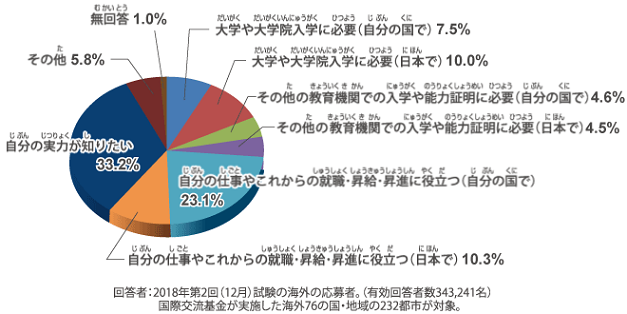JLPT N4 Practice Test
Discover the essentials of JLPT N4 on this page, designed for beginners of Japanese language proficiency.
Here, we provide a concise overview of the exam’s structure and key components, along with a practice test to help you gauge your preparation.

All About JLPT N4 with N4 Practice Test
What Japanese Language Learners Need to Know to Pass JLPT N4
- What kind of test is the Japanese-Language Proficiency Test for Foreigners?
- What is the difficulty level of the N4?
- What are the questions on the N4 exam like?
- What level of Japanese language proficiency can I expect on the JLPT N4?
All the questions that learners who want to pass the JLPT N4 exam need to know will be answered.
Click here for Japanese lessons with the best Japanese tutors for pasing the JLPT.
It is held twice a year, in early July and December.
To apply for the upcoming JLPT N4 exam, please click here:

Take the JLPT N4 practice test now
Let’s try a JLPT N4 mock test.
Vocabulary: 30 min, Reading: 60min, Listening: 35min
This practice test is slightly different from the actual number of exam questions and question format on the actual N4 test. Please purchase the latest practice exam questions to make sure. Source: Japanese-Language Proficiency Test Worldwide Official Website.
If you have any questions, ask them for free! ➡ Japanese Question Form
Kanji List for Passing JLPT N4
This is a list of Chinese characters required to pass JLPT N4. Learn to pass 166 Chinese characters.
What you will learn
- Identify your weaknesses in the N4 level of Japanese.
- Help you get used to the format of the questions and time allocation.
- Practice the exam multiple times to ensure you increase your chances of scoring well.
- Understand the knowledge directly related to the exam.
Requirements - Print out the question sheet and answer sheet before taking the test. After the test, please check your answers according to the correct answer sheet and listening script.
- The listening question files are only available online.
Advantages of taking the JLPT N4
The exam is often taken to meet the requirements for becoming a candidate for nurses and care workers under the EPA (Economic Partnership Agreement).
If you are in Japan, looking for a job or planning to pursue an education, then your JLPT score will come in handy. JLPT certification is also advantageous if you plan to move to Japan. However, the JLPT is only useful for employment and immigration if you have passed N2 or N1. In this page, we focus on JLPT N4.
Nevertheless, the JLPT N4 exam can be an appropriate target for learners of Japanese who want to test their comprehension and basic Japanese knowledge. By taking the N4 exam, you may be able to discover your strengths and weaknesses and subsequently study more efficiently.
In addition, the N4 certification proves your mastery of basic Japanese and prepares you for the more difficult material covered at higher JLPT levels.
The number of test takers for the JLPT (Japanese Language Proficiency Test)
The number of test takers for the JLPT continues to grow every year.
The reason for this is that the number of people learning Japanese is increasing every year.

Refer to the JLPT official website.
- According to the latest data, the number of examinees per year exceeds about 1 million. (Exams held in July and December 2019)
- According to the latest data, the annual number of examinees is over 1 million.
- The number of examinees by level is as follows: N2, N3, N1, N4, and N5.
- JLPT N2 has the highest number of examinees, and JLPT N5 has the lowest number of examinees.
- In addition, the number of test takers by level is skewed by country and region.
- In East Asia, such as South Korea and China, the number of examinees taking the JLPT N1 and N2 tends to be higher.
- In Southeast Asia, such as Thailand and Vietnam, the number of examinees for JLPT N3, N4, and N5 is higher.
JLPT N4 Test Outline
| 言語知識(文字・語彙) | 25分 |
| 言語知識(文法)・読解 | 55分 |
| 聴解 | 35分 |
| 合計115分 |
Refer to the JLPT official website.
The JLPT N4 test is designed for beginning-level students. In general, the JLPT N4 tests your understanding of the core basics of the Japanese language, including basic vocabulary and the ability to read and understand sentences on everyday topics written in kanji. You also need to be able to listen to and follow conversations spoken slowly in everyday situations.
How difficult is the JLPT N4?
- If you pass N4, you can be certified as being at the level of “able to understand basic Japanese.
Please refer to the text below for the specific level of “reading” and “listening” ability!
| Guidelines for JLPT N5 Certification | |
| Able to understand basic Japanese. | |
| Reading | Able to read and understand sentences on familiar topics in daily life written using basic vocabulary and kanji. |
| Listening | Can understand most of the content of conversations spoken rather slowly in everyday situations. |
Refer to the JLPT official website.
As a whole, N4 to N5 are “levels that can understand basic Japanese”, N3 is “daily conversation level Japanese”, and N1 to N2 are “levels that can understand higher level Japanese than everyday conversation”. It is set.
In all three of the above sections, you will need to master approximately 1500 vocabulary and 300 kanji. The 1500 vocabulary covered in the N4 exam includes basic nouns and verbs, as well as commonly used expressions, adjectives, adverbs, and a few katakana words. 300 N4 kanji will help you survive in general situations, although reading native-level Japanese texts may still be difficult after mastering the N4 kanji. You will be able to survive.
In addition, you should be familiar with typical grammar points such as basic particle usage and formal and casual conjugations of verbs and adjectives in the past and present tenses.
Passing Score and Pass Rate
- N4 is a 180-point test with a passing score of 90.
- It is not enough to have a total score of 90 points in all parts, but you also need to have a minimum score of 38 points in language knowledge and reading comprehension, and 19 points in listening comprehension in each part.
| JLPT N4 Passing Score (JLPT N4の合格点) | |
| Score Classification 得点区分 | Score Range 得点の範囲 |
| Language knowledge (letters, vocabulary, grammar), reading comprehension 言語知識(文字・語彙・文法)・読解 | 0-120 (standard score: 38 points) |
| Listening comprehension 聴解 | 0~60 (standard score 19 points) |
| Total Score | 0~180 |
- The pass rate is about 30 to 43% every year.
What is the Japanese Language Proficiency Test (JLPT)?
Overview of the JLPT
The Japanese-Language Proficiency Test (JLPT) is a language proficiency test for non-native speakers of Japanese (Japanese nationals are also eligible to take the test).
- Sponsored by: Japan Educational Exchanges and Services and The Japan Foundation
- It has been conducted since 1984.
- Can be taken in Japan and in 87 countries and regions around the world
- Date of administration: Basically July and December (twice a year)
- English name: “Japanese-Language Proficiency Test (JLPT)
Features of the JLPT exam
There are a total of five levels in this exam. There are five levels: N1, N2, N3, N4, and N5, with N1 being the highest level.
The test is divided into three parts:
1) language knowledge (characters, vocabulary, grammar),
2) reading comprehension
3) listening comprehension.
There are no written questions, all questions are mark-response type.
Why Foreigners Take the JLPT|Advantages
More than half of the people who take the JLPT do so for the following reasons: “To enter a graduate school or university when studying abroad” or “To get a job or a raise in salary.
Specifically, many people take the test for the following purposes and advantages
- To meet the requirements for admission to a Japanese university.
- To meet the requirements for employment or to show off their language skills
- To meet the requirements for salary increase or promotion in the company
- To obtain points to receive preferential treatment for “advanced foreign human resources” visas (N1 and N2 only)
- To meet the requirements for taking the Japanese national examination (N1)
- To be exempted from some subjects of the Japanese Junior High School Graduation Certificate Examination (N1, N2)
- One of the conditions for selecting nurse and care worker candidates for the EPA (Economic Partnership Agreement) (N5~N3)

Attributes of JLPT test takers
Refer to the JLPT official website
How to take the exam
If you would like to take the Japanese Language Proficiency Test in Japan, please apply online.
How to apply: After registering for MyJLPT on the JLPT homepage of the Japanese Language Proficiency Test (JESS), you need to log in to MyJLPT and apply from the “JLPT application” screen.
For details, see the website of the Japanese Language Proficiency Test.
My JLPT registration login website
How do you know the result of JLPT?
Those who took the exam in Japan: Please log in to MyJLPT to apply, or apply from your transcript application ID. You can check your JLPT results by logging in to MyJLPT.
You may not have N4 level speaking and writing skills!
The JLPT exam does not test speaking, so learners of Japanese who are not used to speaking in Japanese can theoretically pass, as long as they have mastered the vocabulary, kanji, and grammar covered in the N4 exam. However, if you are serious about your future in Japan, you will need to be able to speak Japanese for a living!
Summary [Japanese Language Proficiency Test N4 level]
- Tested for the purpose of studying abroad, finding a job, getting a raise or promotion, obtaining a visa, etc.
- There are N1 to N5 levels (N1 is the most difficult).
- The N4 level is “able to understand basic Japanese.
- The passing score for N4 is 90 points, and the passing rate is about 30 to 43%.
- Test to measure knowledge of vocabulary and grammar, reading comprehension, and listening comprehension





